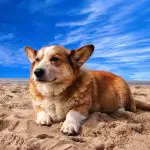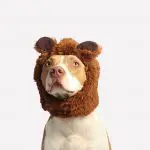Great dane puppy and dog information
The Great Dane makes a good pet for those looking for a very large dog. She makes a good watch dog and only a fool would challenge her. She loves her human family and only needs moderate exercise. She is good with children but dangerous because of her size, especially to very young children. As a reminder, never leave a child unsupervised with any puppy or dog. She is slow to mature and very clumsy and rambunctious as a puppy. They may not get along with other dogs, especially same sex dogs, unless well socialized as a puppy.
*Approximate Adult Size. The approximate adult size (two years old or older) of the male Great Dane is 30 to 34 inches to the withers (highest point of the shoulder) and 120 to 200 pounds. The female ranges from 28 to 32 inches to the withers and 100 to 130 pounds.
*Special Health Considerations. Most dog breeds have certain inherited health problems associated with that specific breed and the Great Dane is no exception. Be on the lookout for Canine Hip Dysplasia (genetic based looseness in the hip joint that can lead to arthritis pain and lameness), bloat (Gastric Dilation-Volvulus, the second leading killer of dogs, can kill within the hour, this space is too limited for a complete explanation but you should read up on this). Feeding more then once a day and avoiding exercise right after meals may help guard against bloat and genetic heart problems, and hypothyroidism (sluggish thyroid gland which can result in weight gain). This disease list is an informative guideline only. Other diseases may also be significant threats, please contact your veterinarian for a complete list.
She should visit the veterinarian several times in the first year for shots, boosters and check up. Then, as an adult, she should visit the veterinarian yearly for shots and check up. As she gets older, six years and on, she should visit the veterinarian twice a year for check ups and shots. Remember; avoid feeding your dog sweets.
*Grooming. The Great Dane has a short, smooth glossy coat. She needs little in coat maintenance. She sheds average and needs weekly brushing. This will help her maintain a clean and healthy coat and help you keep a closer eye on her health and strengthen your emotional bond with her.
Her teeth should be brushed at least twice a week with toothpaste and toothbrush designed for dogs. Brushing removes the accumulation of plaque and tartar which can cause cavities (rarely) and periodontal disease. Dog periodontal disease can lead to pain, loss of teeth, bad breath and other serious disease.
Her toenails may need to be examined for growth and clipped regularly. The toenails of the rear feet grow slower than the toenails of the front feet. Generally a guillotine type trimmer is the best for this chore and competent instructions to accomplish this can be found on the net.
*Life Span. The Great Dane can live between 7 and 10 years with proper nutrition, medical care and excellent living conditions.
*History. The Great Dane comes from Germany and were used to hunt boar. They may have been developed from interbreeding the Boarhound, Irish Wolfhound and ancient Mastiff. They were first registered by the American Kennel Association in 1887.
Some Registries: *Great Dane Club of America *UKC United Kennel Club *NKC National Kennel Club *CKC Continental Kennel Club *APRI Americas Pet Registry Inc. *AKC American Kennel Club *FCI Federation Cynologique Internationale *NZKC New Zealand Kennel Club *KCGB = Kennel Club of Great Britain *ANKC = Australian National Kennel Club *ACR = American Canine Registry
Litter Size: 5 to 12 Great Dane puppies
Category: Working. Mastiff.
Terms To Describe: Strength, dignity, regal, great size, power, dependable, friendly, courageous,
*SPECIAL GOOD POINTS Good watch dog. Generally loving and very gentle. Does not need much grooming. Not a barker.
*SPECIAL BAD POINTS Poor guard dog but they can be scary. Can be stubborn. Can be hard to train. Grow up slow. Puppies are clumsy and thus dangerous to toddlers. Short lived.
*Other Names Known By: Deutsche Dogge, German Mastiff, Ulm Dog
*Every dog is an individual so not everything in this information may be correct for your dog. This information is meant as a good faith guideline only.


